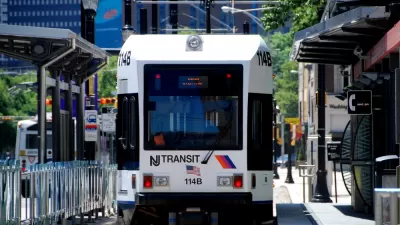The National Transportation Safety Board has determined that the minute before the Sept. 29 crash, the engineer suddenly accelerated, hurling the train into the wall of Hoboken Terminal, killing one person. They will work to find out why.
"In the minute before the crash, the train had been moving toward the platform at just eight miles per hour, the National Transportation Safety Board said," reports Emma G. Fitzsimmons, transit correspondent for The New York Times. The event recorder shows that the engineer then accelerated "to about 21 miles per hour...The speed limit for trains entering the busy station is 10 m.p.h."
Investigators have interviewed the train’s engineer, Thomas Gallagher, 48, who told them he did not remember the accident and woke up on the floor of the cab after the train had stopped.
While train safety experts urged for "automatic braking system" in the form of positive train control, Fitzsimmons writes, "Investigators said they did not know whether the technology would have prevented the crash in Hoboken."
One safeguard New Jersey Transit implemented on Oct. 5 for Hoboken and Atlantic City train terminals is to require "a second crew member to join the train engineer in the operating cab," adds Fitzsimmons. "The measure was aimed at providing a second set of eyes and ears during the final segment of trips into those stations."
On Oct. 1, Fitzsimmons reported that the Federal Railroad Administration "began an audit in June of New Jersey Transit...after noticing an increase in safety violations and a leadership vacuum at the top of the agency...After completing the audit, the federal agency issued a series of violations to the railroad, the official said."
A prescient Planetizen post appeared two days before the fatal crash noting that the NJ Transit’s board of directors had not held a public meeting in 109 days.
"Without public meetings, [legislators, transit riders and advocates] say, it’s impossible to know whether the political fight over state transportation funding is hurting NJ Transit’s ability to operate trains and buses safely."
Good news for NJ Transit commuters: The transit agency will "reopen a portion of Hoboken Terminal to commuter rail service for the start of service on Monday, October 10, 2016," according to a service alert.
FULL STORY: Train Was Traveling at Twice the Speed Limit Just Before Hoboken Crash

Alabama: Trump Terminates Settlements for Black Communities Harmed By Raw Sewage
Trump deemed the landmark civil rights agreement “illegal DEI and environmental justice policy.”

Study: Maui’s Plan to Convert Vacation Rentals to Long-Term Housing Could Cause Nearly $1 Billion Economic Loss
The plan would reduce visitor accommodation by 25% resulting in 1,900 jobs lost.

Why Should We Subsidize Public Transportation?
Many public transit agencies face financial stress due to rising costs, declining fare revenue, and declining subsidies. Transit advocates must provide a strong business case for increasing public transit funding.

Paris Bike Boom Leads to Steep Drop in Air Pollution
The French city’s air quality has improved dramatically in the past 20 years, coinciding with a growth in cycling.

Why Housing Costs More to Build in California Than in Texas
Hard costs like labor and materials combined with ‘soft’ costs such as permitting make building in the San Francisco Bay Area almost three times as costly as in Texas cities.

San Diego County Sees a Rise in Urban Coyotes
San Diego County experiences a rise in urban coyotes, as sightings become prevalent throughout its urban neighbourhoods and surrounding areas.
Urban Design for Planners 1: Software Tools
This six-course series explores essential urban design concepts using open source software and equips planners with the tools they need to participate fully in the urban design process.
Planning for Universal Design
Learn the tools for implementing Universal Design in planning regulations.
Smith Gee Studio
Alamo Area Metropolitan Planning Organization
City of Santa Clarita
Institute for Housing and Urban Development Studies (IHS)
City of Grandview
Harvard GSD Executive Education
Toledo-Lucas County Plan Commissions
Salt Lake City
NYU Wagner Graduate School of Public Service



























